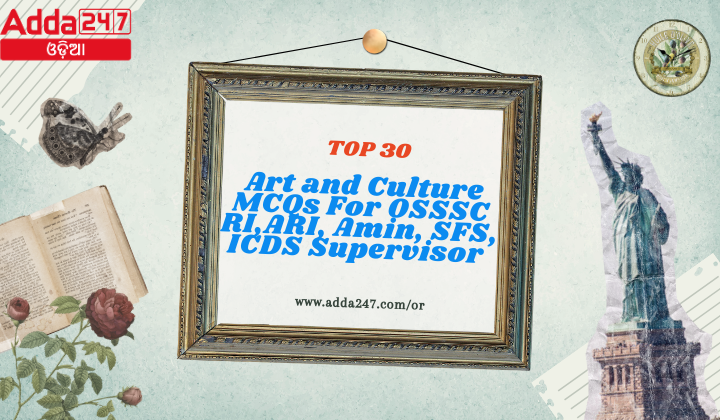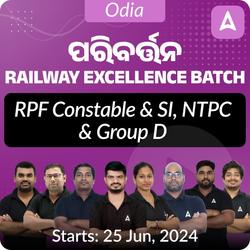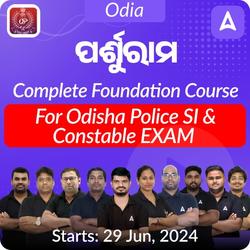Top 30 Art and Culture MCQs For OSSSC RI,ARI, Amin, SFS, ICDS Supervisor
- Which of the following caves is an example of an apsidal vault-roof chaitya hall?
a) Ellora Cave No. 16
b) Ajanta Cave No. 9
c) Elephanta Cave
d) Karla Cave
Answer: b) Ajanta Cave No. 9 - The highest number of cave excavations, more than 200, is found at which site?
a) Kanheri
b) Ellora
c) Junnar
d) Ajanta
Answer: c) Junnar - Which of the following sites has the largest rock-cut chaitya hall?
a) Bhaja
b) Pitalkhora
c) Karla
d) Kanheri
Answer: c) Karla - What is the distinguishing feature of the caves at Kondivite in Mumbai?
a) Apsidal vault-roof chaitya halls
b) Pillarless halls
c) Chaitya arch
d) Absence of a chaitya arch
Answer: d) Absence of a chaitya arch - Which period does the Konkan Maurya inscription, indicating continued cave activity, correspond to?
a) 322 AD
b) 400 AD
c) 1st century BC
d) 2nd century AD
Answer: b) 400 AD - Which is the only remaining example of 1st century BC and 5th century AD paintings?
a) Ellora
b) Mahabalipuram
c) Ajanta
d) Badami
Answer: c) Ajanta - Who was the chief patron of Ajanta Cave No. 16?
a) Upendragupta
b) Varahadeva
c) Buddhabhadra
d) Mathuradasa
Answer: b) Varahadeva - Which cave at Ellora is known for its rock-cut temple carved out of a single rock?
a) Cave No. 12
b) Cave No. 14
c) Cave No. 16
d) Cave No. 19
Answer: c) Cave No. 16 (Kailashleni) - Which of the following is not a prominent theme in the Brahmanical caves at Ellora?
a) Andhakasurvadha
b) Ravana shaking Mt. Kailas
c) Padmapani
d) Kalyanasundara
Answer: c) Padmapani - Where are the biggest rock-cut stupas in India found?
a) Badami
b) Guntapalle
c) Anakapalli
d) Udaigiri-Khandagiri
Answer: c) Anakapalli - What is the name of the technique used in ancient Indian bronze sculpting, known from the time of the Indus Valley Civilization?
a) Lost Wax Technique
b) Stone Carving
c) Metal Forging
d) Sand Casting
Answer: a) Lost Wax Technique - Bronze is primarily an alloy of which two metals?
a) Copper and Zinc
b) Copper and Tin
c) Copper and Iron
d) Copper and Nickel
Answer: b) Copper and Tin - The statue of the Dancing Girl from Mohenjo Daro is an example of which civilization’s art?
a) Mesopotamian
b) Indus Valley
c) Egyptian
d) Greek
Answer: b) Indus Valley - The Chola bronze art, which is highly sought after today, was developed during which period?
a) 8th – 10th century CE
b) 10th – 12th century CE
c) 12th – 14th century CE
d) 14th – 16th century CE
Answer: b) 10th – 12th century CE - Which famous bronze image from the Chola period depicts Shiva as the ‘Lord of the Dance’?
a) Ardhanarisvara
b) Kalyanasundara Murti
c) Nataraja
d) Vaikuntha Vishnu
Answer: c) Nataraja - In the Nataraja bronze sculpture, what does Shiva’s upper right-hand hold?
a) A flame
b) A Damaru (percussion instrument)
c) A trident
d) A lotus
Answer: b) A Damaru (percussion instrument) - Which region’s bronze sculptures show the influence of the 3rd century Amaravati style from Andhra Pradesh?
a) Bengal
b) Bihar
c) Maharashtra
d) Tamil Nadu
Answer: c) Maharashtra - During which period did the Nalanda School of Bronze emerge?
a) 5th century CE
b) 7th century CE
c) 9th century CE
d) 11th century CE
Answer: c) 9th century CE - What is the unique feature of the bronze sculptures found in Himachal Pradesh and Kashmir from the 8th to 10th centuries?
a) Detailed facial expressions
b) Use of gold and silver inlays
c) Different types of iconography of Vishnu images
d) Larger-than-life sizes
Answer: c) Different types of iconography of Vishnu images - Which patron is noted for her support of Chola bronze work, particularly in the 10th century?
a) Rani Durgavati
b) Sembiyan Maha Devi
c) Rani Rudrama Devi
d) Ahilyabai Holkar
Answer: b) Sembiyan Maha Devi - Which districts in Maharashtra are the Katkari tribe primarily found?
a) Pune, Nagpur, and Nashik
b) Raigad, Palghar, Ratnagiri, and Thane
c) Mumbai, Kolhapur, and Aurangabad
d) Solapur, Amravati, and Satara
Answer: b) Raigad, Palghar, Ratnagiri, and Thane - The Katkari people are also known as:
a) Gond
b) Bhil
c) Kathodis
d) Santhal
Answer: c) Kathodis - The name ‘Katkari’ is derived from which activity?
a) Hunting
b) Making and bartering ‘Catechu’ from Khair tree
c) Fishing
d) Pottery
Answer: b) Making and bartering ‘Catechu’ from Khair tree - Apart from agricultural labor, what other activities do Katkari people engage in for their livelihood?
a) Mining and weaving
b) Selling firewood, fishing, coal making, and brick manufacturing
c) Construction work and metalwork
d) Teaching and healthcare
Answer: b) Selling firewood, fishing, coal making, and brick manufacturing - Which languages are spoken by the Katkari tribe?
a) Hindi and Gujarati
b) Marathi and Katkari language
c) Telugu and Kannada
d) Bengali and Odia
Answer: b) Marathi and Katkari language - The festival ‘Undir Navmi’ celebrated by the Katkari tribe is dedicated to which animal?
a) Elephant
b) Cow
c) Rodent
d) Tiger
Answer: c) Rodent - How did the Katkari tribe adapt their business during the COVID-19 pandemic?
a) They relied on government aid exclusively
b) They shifted to online mediums to market their products
c) They ceased all business activities
d) They migrated to urban areas for jobs
Answer: b) They shifted to online mediums to market their products - What is Giloy, which the Katkari tribe markets?
a) A type of grain
b) A medicinal plant
c) A type of fish
d) A variety of fruit
Answer: b) A medicinal plant - Under which scheme did the Katkari youth Sunil Pawar expand the market for local produce online?
a) Pradhan Mantri Fasal Bima Yojana
b) Pradhan Mantri Van Dhan Yojana (PMVDY)
c) Swachh Bharat Abhiyan
d) Digital India Mission
Answer: b) Pradhan Mantri Van Dhan Yojana (PMVDY) - What classification does the Katkari tribe fall under as per the Ministry of Home Affairs?
a) Scheduled Caste
b) Scheduled Tribe
c) Other Backward Class
d) Particularly Vulnerable Tribal Group (PVTG)
Answer: d) Particularly Vulnerable Tribal Group (PVTG)










